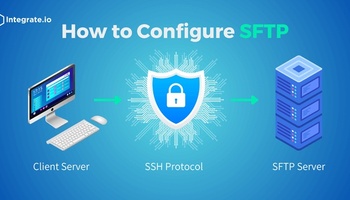- Offer Extensive Role-Appropriate Training for Everyone in Your Organization
- Keep All Systems Documented and Updated
- Implement the Principle of Least Privilege
- Put Multi-factor Authentication in Place
- Conduct Routine Security Audits
- Keep Track of External Vendor and Contractor Access
- Don’t Overlook Physical Security
- Watch for Internal Threats
- Use Security Measures that Accommodate Remote Workers
- Make Your Data Integration More Secure
Data security threats can have a devastating impact on your organization, from unexpected downtime to a loss of consumer trust. Following data security best practices gives your company a multi-faceted approach to responding to new threats and minimizing the damage potential of zero-day attacks. Below we cover ten of the best safeguards to keep you and your company safe against common risks you may encounter in your operations.
1) Offer Extensive Role-Appropriate Training for Everyone in Your Organization
Everyone in your company has a part to play in data security, even if they lack technical skills. A cybersecurity aware organization understands the telltale signs of potential security concerns, such as what a phishing email looks like. Training on social engineering tactics is also important, as staff outside of the IT department may not realize these attack methods are taking place. The training program should be ongoing and offered in many forms to get as many people as possible educated on the topic.
Cybersecurity training is not a one-and-done process, since hackers come up with new techniques on a regular basis and compliance measures change over time. Keep all staff members up-to-date on the most important information through refresher courses and continuing education opportunities. Ensure that these resources are also available to new hires as part of the onboarding process.
2) Keep All Systems Documented and Updated
You can’t protect systems that you don’t know about. Shadow IT is a major problem for data security, as sensitive data may be stored in unprotected and unauthorized services, obsolete applications offer attractive attack surfaces for hackers, and a lack of application standardization leads to more silos in the organization. You also need a way to keep all systems updated to reduce the risk of known exploits being introduced to your network.
3) Implement the Principle of Least Privilege
Overly broad account privileges form the basis of many data breaches, whether it’s an ex-employee account that remained active or a user that has full administrator access for no discernible reason. The principle of least privilege limits data access so that each user, role, team, or department only has as much access as they actually need. By putting this data security best practice in place, you also make it easier to monitor user accounts for unusual activity.
4) Put Multi-factor Authentication and Strong Password Policies in Place
How do staff members access your organization’s network resources? Usernames and passwords alone are not a strong enough measure to stop unauthorized access from occurring, especially if you don’t have strict password requirements in place. Multi-factor authentication uses additional methods for verifying someone’s identity. It may include biometric markers, hardware keys, key cards, PIN codes, and other options.
5) Conduct Routine Security Audits
Don’t wait until you have a data security incident before you audit your systems. A security audit should be a frequent occurrence for your organization so you can identify potential weak spots in your protection. When you’re proactive about your data security, you can catch intruders early on or discover signs of attacks before critical systems get hit. Try to vary the schedule so you don't fall into a habit of being too predictable. You could end up dealing with a savvy hacker that figured out a way to beat your routine.
6) Keep Track of External Vendor and Contractor Access
How many external parties have access to your organization’s infrastructure? Have they suffered from any security incidents recently? Do they have ongoing access to your systems even if they’re not currently working with you? Be strict with these accounts and remove their authorization in-between projects. Third-party companies have caused many types of data breaches and security incidents, so it’s important to minimize that risk before it becomes a problem.
7) Don’t Overlook Physical Security
Physical security frequently gets overlooked in data security strategies, even though it can prevent devastating attacks that are large-scale and expensive to address. Determine where an attacker may be able to physically access sensitive data and systems, and use access control to restrict these areas and equipment. Much like your infrastructure access, keep people out of areas that don’t pertain to their roles. Your administrative staff probably doesn’t need to walk around in a server room, for example. Emphasizing social engineering tactics in the training program mentioned earlier also helps improve your physical security.
8) Watch for Internal Threats
Do you have malicious actors among your organization’s staff? It may be difficult to pick these attackers out at first, as they could behave like normal employees. By maintaining tight control on user accounts and physical security, you can narrow down the potential list by noting any unusual behavior.
9) Use Security Measures that Accommodate Remote Workers
The COVID-19 pandemic rapidly advanced the remote work world, which is not without its growing pains. If your organization focused heavily on perimeter defense measures in data security, then you face several challenges with remote workers. They may have a hard time accessing the databases and systems they need to do their job, or your systems may have vulnerabilities in place due to unsecured home networks. Revisit your data security strategy and adapt to this new environment with solutions that support a distributed workforce.
10) Make Your Data Integration More Secure
As your organization works with an ever-growing collection of data sources, keeping your integration processes secure becomes critical. Integrate.io offers a powerful data integration platform that streamlines API management and reduces the complexity that could create vulnerabilities. Schedule a seven-day demo of Integrate.io today.










